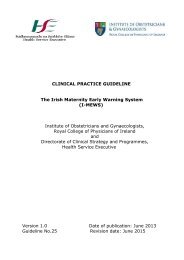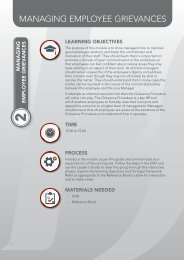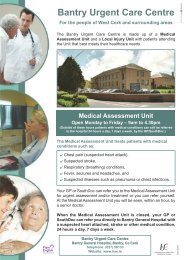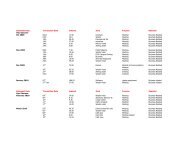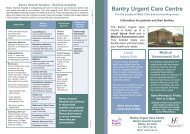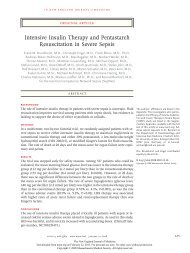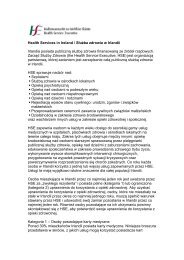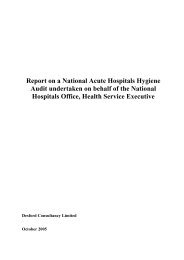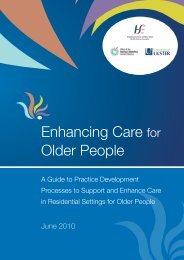Galway and Roscommon University Hospital Group Service Plan ...
Galway and Roscommon University Hospital Group Service Plan ...
Galway and Roscommon University Hospital Group Service Plan ...
Create successful ePaper yourself
Turn your PDF publications into a flip-book with our unique Google optimized e-Paper software.
<strong>Galway</strong> <strong>and</strong> <strong>Roscommon</strong> <strong>University</strong> <strong>Hospital</strong>s <strong>Group</strong><br />
<strong>Service</strong> <strong>Plan</strong> 2013<br />
28 February, 2013
Contents<br />
<strong>Group</strong> <strong>Service</strong> <strong>Plan</strong><br />
Introduction 1<br />
Context 1<br />
Reforming Our Health <strong>Service</strong>s 2<br />
<strong>Group</strong>’s <strong>Service</strong> Objectives for 2013 3<br />
2013 <strong>Service</strong> Objectives 3<br />
Finance 6<br />
Introduction 6<br />
Summary of the <strong>Group</strong> Financial Position 2013 6<br />
Cost Containment 8<br />
Information Technology 11<br />
Medical <strong>Service</strong>s <strong>and</strong> Quality <strong>and</strong> Safety 12<br />
Medical Manpower 12<br />
Improving Quality <strong>and</strong> Delivering Safe <strong>Service</strong>s 13<br />
Cancer Care 14<br />
Nursing <strong>and</strong> Midwifery <strong>Service</strong>s 16<br />
Nursing <strong>and</strong> Midwifery <strong>Service</strong> Objectives 16<br />
Operational Challenges 18<br />
Activity <strong>Plan</strong> 18<br />
Scheduled Care 19<br />
Unscheduled Care 20<br />
Estates Strategy 21<br />
Human Resources 22<br />
Employment Control Framework Challenge 22<br />
Appendices 25<br />
Appendix 1 – Clinical Directorate Priorities 2013 25<br />
Appendix 2 – <strong>Hospital</strong> Priorities 28<br />
Appendix 3 – Performance Activity Indicators by <strong>Hospital</strong> 31
Introduction – <strong>Group</strong> CEO<br />
Mr Bill Maher<br />
Context<br />
The National <strong>Service</strong> <strong>Plan</strong> 2013 (NSP 2013), approved by the Minister on 09 January<br />
2013, sets out the type <strong>and</strong> volume of services to be delivered by the Health Sector in<br />
2013 <strong>and</strong> is informed by the Department of Health’s Statement of Strategy 2011 –<br />
2014 <strong>and</strong> Future Health, a Strategic Framework for Reform of the Health <strong>Service</strong> 2012<br />
– 2015, both of which set out the Government’s priorities for the health services.<br />
The <strong>Group</strong> is committed to supporting the Programme for Government change agenda<br />
which will bring about significant changes to the way health services are managed <strong>and</strong><br />
delivered in 2013 <strong>and</strong> beyond.<br />
This <strong>Group</strong> <strong>Service</strong> <strong>Plan</strong> builds on the firm foundations laid in 2012 in terms of service<br />
delivery, reducing waiting times, establishing sound governance arrangements <strong>and</strong><br />
improving patient quality.<br />
1
Reforming Our Health <strong>Service</strong>s<br />
In November 2012, the Minister for Health published Future Health, the framework for<br />
health reform. This framework, based on Government commitments in its Programme<br />
for Government, outlines the main healthcare reforms that will be introduced in the<br />
coming years as key building blocks for the introduction of Universal Health Insurance<br />
in 2016.<br />
Future Health seeks to support innovative ways of care delivery <strong>and</strong> in particular<br />
integrated care pathways. All this must be achieved under the most stringent fiscal<br />
constraints experienced for decades <strong>and</strong> cognisant of health trends <strong>and</strong> drivers of<br />
change such as:<br />
• Increased activity<br />
• Demographic <strong>and</strong> societal change<br />
• New medical technologies, health informatics <strong>and</strong> telemedicine<br />
• Rising expectations <strong>and</strong> dem<strong>and</strong>s<br />
• Spiralling costs of healthcare provision<br />
• Growing external scrutiny<br />
The health services <strong>and</strong> our <strong>Group</strong> continue to experience very significant budgetary<br />
challenges alongside increased dem<strong>and</strong>s for services. We also face the challenge of<br />
reducing costs while at the same time improving outcomes for our patients, <strong>and</strong><br />
reducing access times.<br />
We will continue to introduce models of care across all our services which treat<br />
patients at the lowest level of complexity <strong>and</strong> provide services at the least possible<br />
unit cost based on best practice where possible, <strong>and</strong> to quality st<strong>and</strong>ards set by HIQA.<br />
2 -
<strong>Group</strong>’s <strong>Service</strong> Objectives for 2013<br />
The primary focus in 2012 was to establish the governance foundations to address our<br />
immediate operational challenges <strong>and</strong> set out a strategy to realise the <strong>Group</strong>’s full<br />
potential. Initial governance arrangements have been developed internally with the<br />
establishment of a <strong>Group</strong> Executive Council, <strong>Group</strong> Management Team <strong>and</strong> a Clinical<br />
Directors Forum with agreed governance <strong>and</strong> reporting model.<br />
At the heart of this governance is our Clinical Directorate Structure <strong>and</strong> we will further<br />
develop this in 2013.<br />
The key priorities for the <strong>Group</strong> in 2012 were to continue to improve the quality of<br />
care provided while enhancing accessibility to hospital services <strong>and</strong> improving the<br />
morale of our staff.<br />
These priorities were set in the context of reducing our cost base <strong>and</strong> improving our<br />
overall financial performance. They were also set in the context of a growing dem<strong>and</strong><br />
for health services generally <strong>and</strong> for hospital services in particular, as well as the loss<br />
of key personnel arising from the Pension Protected Retirement Scheme.<br />
The <strong>Group</strong> was successful in achieving its key priorities in 2012, including significant<br />
progress in maximisation of its resources through better integration, significant<br />
improvement in trolley waits, achieving stringent Patient Target List (PTL) targets,<br />
establishing governance arrangements, real engagement with Clinical Care<br />
Programmes <strong>and</strong> integrating the new group of hospitals.<br />
2013 <strong>Service</strong> Objectives<br />
For 2013 the <strong>Group</strong> will continue to develop its governance structures including a fully<br />
functional Board of Directors <strong>and</strong> an appropriate Governance Framework. We will also<br />
hold a number of board meetings in public, providing real local accountability to the<br />
public we serve.<br />
We will incorporate new hospital additions into the <strong>Group</strong> as recommended by the<br />
Professor Higgins report within our corporate clinical governance model.<br />
3 -
We will deliver the following level of patient activity (based on the existing hospitals<br />
within the <strong>Group</strong>):<br />
<strong>Group</strong> Activity<br />
Target<br />
Inpatients 50,953<br />
Day Cases 90,377<br />
ED Presentations 89,784<br />
Births 5,441<br />
Outpatients 291,532<br />
Urgent Care Centre 5,440<br />
• Delivery of services will be managed across the <strong>Group</strong> of hospitals maximising<br />
integration options at all times. We will take cognisance of national targets in terms<br />
of inpatient <strong>and</strong> outpatient waiting list targets as follows:<br />
Scheduled Activity<br />
Inpatient / Day Case<br />
Outpatient<br />
Paediatric<br />
GI Endoscopy<br />
Target<br />
No adult waiting longer than 8 months for an elective<br />
procedure<br />
No person waiting longer than 52 weeks for an<br />
appointment<br />
No child waiting longer than 20 weeks for an elective<br />
procedure<br />
No person waiting longer than 13 weeks for procedure<br />
• We will also meet the access targets set out for unscheduled care as follows:<br />
− 95% of all attendees at ED will be discharged or admitted within 6 hours of<br />
registration.<br />
− All patients admitted through the ED within 9 hours of registration will be<br />
discharged or admitted.<br />
• 95% of all new medical patients attending the Acute Medical Unit (AMU) are to<br />
spend less than 6 hours from ED registration to AMU departure.<br />
• HIQA st<strong>and</strong>ards are of paramount importance <strong>and</strong> will underpin our service<br />
delivery to deliver patient centred care.<br />
• We will also reflect the implementation of the National Clinical Programmes in all<br />
of our hospitals <strong>and</strong> the service efficiencies derived from the programmes.<br />
• <strong>Service</strong> provision will be delivered by a dedicated work force fully committed to<br />
provide a world class health service to the public.<br />
4 -
• The <strong>Group</strong> will also manage its financial resources <strong>and</strong> ensure that resources are<br />
used effectively, efficiently <strong>and</strong> competitively.<br />
• We will continue to monitor our performance internally through our appropriate<br />
performance management tools <strong>and</strong> we will aim for a GREEN rating in CompStat<br />
across all hospitals.<br />
• We will continue to push for autonomy for the <strong>Group</strong> particularly in the areas of<br />
recruitment <strong>and</strong> procurement as these are fundamental in meeting quality <strong>and</strong><br />
safety st<strong>and</strong>ards as well as efficiency <strong>and</strong> financial stability.<br />
• We will support Government reform <strong>and</strong> changes to the service delivery model for<br />
the former HSE West region.<br />
• We will commence implementation of our ICT strategy <strong>and</strong> implement ICT solutions<br />
that are cost effective <strong>and</strong> service efficient looking for opportunities to partner with<br />
the private sector, where appropriate, to improve service <strong>and</strong> delivery value for<br />
money.<br />
• The <strong>Group</strong> will publish its Strategy 2012-2016 <strong>and</strong> commence implementation of<br />
the key objectives.<br />
• We will develop a succession plan for governance continuity through our Future<br />
Leadership Programme.<br />
• We will continue to develop our communications strategy <strong>and</strong> engage with all key<br />
partners <strong>and</strong> key stakeholders, particularly our staff across the <strong>Group</strong> <strong>and</strong> all the<br />
patients we serve.<br />
• We will develop our learning <strong>and</strong> development strategy to maximise our work force<br />
<strong>and</strong> ensure development of our staff.<br />
Other service plan objectives include:<br />
Implementing a quality <strong>and</strong> safety management system.<br />
Developing nursing <strong>and</strong> midwifery services within the <strong>Group</strong>.<br />
Implementing directorate priorities <strong>and</strong> KPIs – see Appendix 2.<br />
Progressing governance of the Cancer Strategy <strong>Group</strong>.<br />
Embedding the clinical audit programme.<br />
Designing br<strong>and</strong>ing for <strong>Group</strong>.<br />
Establishing international partners.<br />
Establishing a Foundation to maximise charitable donations <strong>and</strong> support capital<br />
developments.<br />
5 -
Finance – <strong>Group</strong> CFO<br />
Mr Maurice Power<br />
Introduction<br />
The NSP 2013 sought to address legacy issues <strong>and</strong> give each budget holder a realistic<br />
budget for 2013 in the context of service levels in 2012. As a result, the <strong>Group</strong> is<br />
starting 2013 in an improved financial position with an increase of €20.9m in our<br />
budget. This is a very positive result for the <strong>Group</strong> albeit it still leaves us with a<br />
financial challenge of approximately €26m to ensure that as a <strong>Group</strong> we manage to<br />
remain within budget in 2013. This will require a continued strong focus on cost<br />
control throughout the organisation, the achievement of value for money (VFM) <strong>and</strong><br />
our ability to maximise our income streams.<br />
Summary of the <strong>Group</strong> Financial Position 2013<br />
The 2013 budget for the <strong>Group</strong> is €318.5m. This is a net increase of €20.9m on the<br />
2012 budget. The increase follows a budget realignment process undertaken by HSE<br />
as part of the <strong>Service</strong> <strong>Plan</strong> 2013 planning stage to assign more realistic budgets to the<br />
<strong>Hospital</strong> Sector. However while the increase is very welcome, it still results in the<br />
<strong>Group</strong> facing a significant financial challenge for 2013 in the order of €26m including<br />
the 2013 cost pressures identified.<br />
Part of the €26m challenge will be achieved by looking at other sources of funding for<br />
non-revenue item expenditure, for example procurement of medical equipment, the<br />
introduction of legislation to allow hospitals to invoice private patients accommodated<br />
in public beds <strong>and</strong> the sourcing of additional funding, (for example, to help deliver our<br />
challenging access targets).<br />
6 -
The balance of approximately €16m will require the implementation of cost<br />
containment measures across the <strong>Group</strong> to address the deficit gap <strong>and</strong> ensure we<br />
break-even by year end. We do not underestimate the challenge <strong>and</strong> it will require<br />
detailed realistic cost containment plans that can be performance managed on a<br />
monthly basis to ensure delivery of the planned saving targets. Our Clinical<br />
Directorates will be key to achieving this.<br />
2013 Finance Objectives<br />
For 2013 the key objectives for <strong>Group</strong> Finance will be:<br />
• Deliver <strong>Group</strong> financial break-even position.<br />
• Implement ABC system <strong>and</strong> Electronic Claims Management System throughout<br />
the <strong>Group</strong>.<br />
• Progress the procurement of financial systems including HR, payroll, approvals<br />
process <strong>and</strong> materials management.<br />
• Secure procurement <strong>and</strong> recruitment control.<br />
• Carry out financial due diligence on potential additional hospitals to join the<br />
<strong>Group</strong>.<br />
• Secure revised bed designation arrangements for <strong>Group</strong>.<br />
• Continue to promote cost containment culture within the <strong>Group</strong>.<br />
• Establish <strong>Group</strong> finance function <strong>and</strong> <strong>Group</strong> audit function (as part of our<br />
corporate governance).<br />
• Review <strong>and</strong> implement strong, robust internal control mechanisms for the<br />
<strong>Group</strong>.<br />
• Develop a <strong>Group</strong> wide casemix strategy.<br />
• Establish <strong>Group</strong> Finance Committee chaired by a Non-Executive Director to<br />
further improve accountability.<br />
<strong>Group</strong> Financial Projections 2013<br />
Annual Budget 2012<br />
€297.6m<br />
Annual Budget 2013<br />
€318.5m<br />
Net Increase<br />
+€20.9m<br />
2013 Forecast (including cost pressures) Expenditure €344.5m<br />
Forecast Gap on Budget<br />
-€26m<br />
Measures<br />
Income from legislation €7m<br />
Deferral of Medical Equipment procurement €4.0m<br />
Cost Containment Measures €15m<br />
Cost Containment<br />
7 -<br />
€m
Cost containment requires a reduction of 5% on the 2013 expected expenditure to<br />
ensure a break-even position having allowed for income legislation, budget <strong>and</strong><br />
deferral of medical equipment.<br />
The <strong>Group</strong> will address the delivery of cost containment plans through a combination<br />
of measures agreed with the Clinical Directorates <strong>and</strong> the individual hospitals’<br />
management, as well as a number of <strong>Group</strong>-wide procurement measures. The primary<br />
objective will be to deliver on plans which minimises the impact on front line services.<br />
The identification of cost containment measures will take into account the nationally<br />
agreed cost containment proposals <strong>and</strong> locally driven proposals. It is important to<br />
note that to remain within the funding level will be a significant challenge particularly<br />
as this is the fourth year that we are required to implement cost containment<br />
measures <strong>and</strong> the significant cost savings, income generation opportunities already<br />
introduced further reduce our ability to go further.<br />
Measures for implementation include:<br />
National Cost Containment:<br />
• Reduction in Non-Consultant <strong>Hospital</strong> Doctor (NCHD) overtime.<br />
• Pre-retirement incentive schemes.<br />
• Career breaks incentive.<br />
• Consultant rest days – reduction in pay.<br />
• Nursing graduates – reducing pay.<br />
• Employment control Figure - reducing headcount where possible.<br />
• Procurement (medical <strong>and</strong> surgical, laboratories, x-ray).<br />
Local Cost Containment:<br />
• Target specific reduction areas<br />
Each hospital will have costs that are specific to their hospital. Local plans will<br />
be developed to identify some savings across these expenditure items.<br />
Examples are grants <strong>and</strong> rental payments.<br />
8 -
• Catering/Cleaning<br />
We are in the process of tendering for our catering <strong>and</strong> cleaning services across<br />
the <strong>Group</strong>. The priority will be to ensure best value in terms of service provision<br />
with a reduced contractual price. Potential savings will be to the latter part of<br />
the year.<br />
• Drugs Control Expenditure<br />
A control monitoring process will be put in place to track expenditure by drug<br />
type, specialty <strong>and</strong> hospital to ensure that we remain within budget. A system<br />
of tracking cancer drug costs is in place so that we can potentially access<br />
additional funding from NCCP for increase levels of expenditure relating to<br />
certain drugs.<br />
• Rosters savings<br />
A review is taking place of nursing rosters to address inefficiencies <strong>and</strong> identify<br />
skill mix requirements. The review is commencing in March 2013 with external<br />
support from the Office of the Nursing <strong>and</strong> Midwifery <strong>Service</strong>s Director<br />
(ONMSD). A review of NCHD rosters is also in progress with objective to<br />
streamline rosters <strong>and</strong> ensure compliance with the European Working Time<br />
Directive (EWTD).<br />
• Premia savings<br />
While there has been significant reduction in premia payments there is still<br />
scope to review further. Savings will be generated from the rosters’ review<br />
outlined above plus additional scope in other staff category pay areas.<br />
• Contractual savings<br />
The <strong>Group</strong> has negotiated a number of contract price reductions during 2012<br />
that will have a full-year effect in 2013. We have also a senior procurement<br />
specialist working with the <strong>Group</strong> for 2013 <strong>and</strong> a significant piece of work will be<br />
to review product prices across the hospitals to ensure that the most<br />
competitive price per product is secured. Consumables groups will be working<br />
in each Directorate to review consumable volumes <strong>and</strong> prices with objective to<br />
rationalise usage <strong>and</strong> reduce price.<br />
9 -
• Agency savings<br />
One of the national targets in 2012 was to reduce agency expenditure by over<br />
50%. We achieved a 32% reduction. We intend to remove use of agency in all<br />
areas except where we have no other alternative due to shortage of suitably<br />
qualified personnel. Where possible we will recruit employees rather than use<br />
agency.<br />
There are a number of large scale initiatives taking place in the <strong>Group</strong> that will<br />
have cost savings if implemented this year. These include the procurement of<br />
an electronic document imaging system, implementation of a debt management<br />
system <strong>and</strong> a number of outsourcing options. They will also contribute to<br />
savings required under Whole Time Equivalent (WTE) ceiling targets. However it<br />
is more likely that the success of these initiatives will have a savings impact from<br />
2014 onwards.<br />
10 -
Information Technology<br />
Introduction<br />
In 2012 the <strong>Group</strong> undertook a review of ICT to support effective delivery <strong>and</strong><br />
interoperability of ICT across the <strong>Group</strong>. The outcome of the review is a proposed<br />
strategy to transform the current ICT service to support the achievement of the <strong>Group</strong><br />
service objectives. This is a significant undertaking <strong>and</strong> one which will require<br />
additional capacity, capability <strong>and</strong> significant funding. We intend to progress the<br />
agreed strategy in 2013.<br />
Operational <strong>Plan</strong><br />
For 2013 we will deliver on the strategy to support patient care <strong>and</strong> corporate<br />
efficiency by:<br />
• Development of a common master patient index.<br />
• Development of electronic patient record solution across the group <strong>and</strong><br />
progress to procurement stage.<br />
• Review ICT structures across the <strong>Group</strong>.<br />
• Development of web-based performance management platform.<br />
• Development of a group intranet.<br />
• Moving Portiuncula into the <strong>Group</strong> network (domain move – infrastructure<br />
project).<br />
• Rollout new systems including endoscopy reporting, medical device track <strong>and</strong><br />
trace systems, blood tracking systems – all at early stages of implementation<br />
planning.<br />
• Rollout systems into priority areas – as per ICT strategy including bed<br />
management, ED <strong>and</strong> theatre management <strong>and</strong> agree consolidation of discharge<br />
summary systems.<br />
• Extension of the <strong>Group</strong> patient correspondence systems to <strong>Roscommon</strong> <strong>and</strong><br />
Portiuncula.<br />
• Development of telephony strategy <strong>and</strong> procure <strong>Group</strong>-wide system (working<br />
with national ICT).<br />
• Enhancement of infrastructure in 2013 including replacing older equipment –<br />
PCs, servers across <strong>Group</strong>.<br />
• Delivery will be governed <strong>and</strong> managed through the ICT steering group.<br />
11 -
Medical <strong>Service</strong>s <strong>and</strong> Quality <strong>and</strong> Safety<br />
– <strong>Group</strong> Clinical Director<br />
Dr Pat Nash<br />
Introduction<br />
My focus for 2013 is to consolidate <strong>and</strong> further develop the clinical governance<br />
structure across the organisation, developing <strong>and</strong> supporting the Clinical Directorates<br />
as the core management units in our organisation. Integral to good clinical<br />
governance is prioritisation of quality <strong>and</strong> patient safety across our hospitals. The<br />
National Clinical Programmes <strong>and</strong> the HIQA st<strong>and</strong>ards will be the driving forces for<br />
this. Balancing the competing dem<strong>and</strong>s between unscheduled <strong>and</strong> scheduled care will<br />
remain a priority during the year, whilst maintaining our focus on delivering a high<br />
quality <strong>and</strong> safe service for all patients.<br />
Medical Manpower<br />
In 2012 there was significant progress made in the development of our Medical<br />
Manpower Strategy including:<br />
• Additional sessions worked by surgeons <strong>and</strong> anaesthesia to target long waiters<br />
in surgery <strong>and</strong> meet the SDU targets.<br />
• Reorganisation of on-call rotas in Medicine between Merlin Park <strong>and</strong> UHG. This<br />
improved medical care to patients <strong>and</strong> reduced associated risk for emergency<br />
medical admissions as well as increasing throughput <strong>and</strong> reduced average length<br />
of stay.<br />
• Revised NCHD rotas between Merlin Park <strong>and</strong> UHG cross cover provided by<br />
Medical Registrar out of hours to orthopaedic patient on the Merlin Park site.<br />
This reduced overtime payments <strong>and</strong> reduced working hours for NCHDs.<br />
• On call rotas have been reviewed in Anaesthesia, Paediatrics <strong>and</strong> Medicine to<br />
provide better cover <strong>and</strong> reduced working hours for NCHDs.<br />
12 -
For 2013:<br />
• Development of a business case <strong>and</strong> the implementation of the ICU Programme<br />
between GUH <strong>and</strong> Portiuncula which will be implemented early 2013. This will<br />
provide enhanced anaesthesia cover to ICU in Portiuncula by GUH Consultants<br />
<strong>and</strong> improve patient safety.<br />
• Plastic surgery - new additional clinics <strong>and</strong> day surgery in <strong>Roscommon</strong><br />
maximising its role as a level 2 hospital.<br />
• Further work was initiated on compliance levels for EWTD amongst NCHDs.<br />
• Additional work will take place to implement compliant rosters for staff in UHG<br />
particularly with Medical Registrars.<br />
• On the <strong>Roscommon</strong> <strong>and</strong> Portiuncula sites we will reconfigure rosters to ensure<br />
efficient service delivery.<br />
• For 2013, rotations have been developed between UHG, <strong>Roscommon</strong> <strong>and</strong><br />
Portiuncula to make posts more attractive on the smaller sites. In addition,<br />
certain posts are been evaluated <strong>and</strong> where possible we may convert some SHO<br />
posts to intern posts. This will lead to quality improvements <strong>and</strong> also meet the<br />
need for additional posts for the increased number of graduates.<br />
Note - ongoing problems in relation to recruitment of NCHDs will continue in the<br />
areas of Emergency Medicine, Paediatrics, Obstetrics <strong>and</strong> Gynaecology. In<br />
addition to these areas the smaller sites can also experience recruitment issues<br />
in General Medicine <strong>and</strong> Surgery. We will minimise the problem by joint<br />
recruitment <strong>and</strong> the provision of rotations between the <strong>Group</strong> hospitals.<br />
Improving Quality <strong>and</strong> Delivering Safe <strong>Service</strong>s<br />
The development, rollout <strong>and</strong> go-live of a quality <strong>and</strong> safety new processes <strong>and</strong><br />
upgraded system is scheduled to be completed in March 2013. A full education <strong>and</strong><br />
roll out programme will be provided to ensure staff have an underst<strong>and</strong>ing of the new<br />
processes, the roles <strong>and</strong> responsibilities, <strong>and</strong> the upgraded Q-Pulse system.<br />
Following go-live, the new processes shall be supported by ongoing education <strong>and</strong><br />
training across the hospital sites. This shall include a support desk (telephone <strong>and</strong><br />
email) for quality <strong>and</strong> safety related queries, as well as the Q-Pulse system.<br />
13 -
A real-time comprehensive monitoring system shall ensure the system is being utilised<br />
appropriately <strong>and</strong> that the information is providing effective benefits to all line<br />
managers, staff <strong>and</strong> ultimately the patients. This monitoring system shall allow for<br />
both automated, <strong>and</strong> manual, escalation of incidents <strong>and</strong> events where required.<br />
Comprehensive monthly reports shall be developed <strong>and</strong> provided on all activities,<br />
incidents, timeframes, classification analysis, trends <strong>and</strong> risks in relation to quality <strong>and</strong><br />
safety events. The provisions of this information shall be a key support to the<br />
operations of the Directorates <strong>and</strong> the newly formed Patient Safety Committee.<br />
We must deliver services that are safe <strong>and</strong> are evidence-based <strong>and</strong> meet regulatory<br />
requirements <strong>and</strong> healthcare st<strong>and</strong>ards. This can be achieved with the continued<br />
development of National Clinical Programmes <strong>and</strong> implementation of the National<br />
St<strong>and</strong>ards for Safer Better Healthcare (HIQA).<br />
We need to address other quality issues such as the monitoring <strong>and</strong> reduction of<br />
<strong>Hospital</strong> Acquired / Staph Aureus Blood Stream Infection Rates, Emergency<br />
Readmission Rates, Rates of Day Surgery <strong>and</strong> Day of Surgery Admission, <strong>and</strong><br />
Average Length of Stay (ALOS).<br />
Audit of waiting times for access to safe stroke thrombolysis, waiting times for<br />
access to interventional cardiology for ST elevation myocardial infarction (STEMI) <strong>and</strong><br />
non-STEMI cases <strong>and</strong> 5 year survival rates for breast, colorectal, prostate <strong>and</strong> cervical<br />
cancer are all areas which provide evidence of quality service.<br />
In admissions we will develop specialty specific admissions projects to redesign<br />
pathways, reduce waiting lists, improve efficiency, support earlier discharges, <strong>and</strong><br />
reduce ALOS <strong>and</strong> ED pressures.<br />
In bed management we will develop a <strong>Group</strong> bed model through procurement of<br />
system solution <strong>and</strong> process reengineering. We will reduce length of stay <strong>and</strong> increase<br />
elective admissions, moving to a model of protected beds. We will streamline<br />
patients’ pathway using expected date of discharge (EDD).<br />
Cancer Care<br />
<strong>Galway</strong> <strong>University</strong> <strong>Hospital</strong>s is one of the eight designated cancer services in the<br />
delivery of a comprehensive National Cancer Control Programme (NCCP) <strong>and</strong><br />
incorporates the diagnostic therapeutic <strong>and</strong> palliative care teams as well as<br />
translational research, clinical trials <strong>and</strong> biobanking.<br />
14 -
We will continue to progress the governance of the <strong>Group</strong>’s Cancer Strategy <strong>Group</strong><br />
<strong>and</strong> the primary objectives for 2013 are:<br />
• Development of a set of KPIs for each cancer specialty group.<br />
• Improvement in patient experience by continuing to develop effective cancer<br />
care pathways.<br />
• Improvement in patient flow in oncology.<br />
• Support the roll out of the National Colorectal Programme.<br />
• Continue to support the transfer of major cancer surgeries into designated<br />
cancer centres (rectal, prostate, GI).<br />
• Continue to deliver rapid access diagnostic clinics.<br />
• Continue to work with NCCP <strong>and</strong> clinicians to develop cancer services <strong>and</strong><br />
capacity alongside existing <strong>Group</strong> service pressures <strong>and</strong> development of GUH as<br />
a centre of excellence.<br />
• Implement the National <strong>Plan</strong> for Radiation Oncology (NPRO) capital programme<br />
<strong>and</strong> the associated enabling works.<br />
15 -
Nursing <strong>and</strong> Midwifery <strong>Service</strong>s<br />
– <strong>Group</strong> Director of Nursing <strong>and</strong> Midwifery<br />
Ms Colette Cowan<br />
Introduction<br />
Nursing <strong>and</strong> Midwifery are committed to achieving the objectives of the <strong>Group</strong>’s<br />
<strong>Service</strong> <strong>Plan</strong> 2013. We are the leaders that drive the st<strong>and</strong>ards for quality of patient<br />
care <strong>and</strong> patient experience. We want to deliver the best service that staff are proud<br />
to deliver, where the essence of care is valued <strong>and</strong> where staff want to work in our<br />
<strong>Group</strong>. Our objectives will be achieved through our key priorities <strong>and</strong> key<br />
performance indicators.<br />
2013 Nursing <strong>and</strong> Midwifery <strong>Service</strong> Objectives<br />
The primary focus for 2013 for Nursing <strong>and</strong> Midwifery is to continue to provide a<br />
patient-centred service that meets the expectations of our service users.<br />
The <strong>Group</strong> nursing structure will be further defined to address strategic <strong>and</strong><br />
operational governance with assigned authority <strong>and</strong> accountability on specific areas of<br />
quality, safety, infection prevention <strong>and</strong> control <strong>and</strong> patient experience. The nursing<br />
directorate will deliver on targets that will be underpinned by the St<strong>and</strong>ards for Better<br />
Safer Healthcare <strong>and</strong> work towards the <strong>Group</strong> achieving licensing. Our Nursing<br />
Strategy will identify the manpower plan for the <strong>Group</strong>.<br />
Priorities:<br />
• The formal transition to a <strong>Group</strong> <strong>and</strong> Board will allow autonomy to the <strong>Group</strong><br />
Director of Nursing <strong>and</strong> Midwifery (DoNM) to manage the nursing budget<br />
efficiently, recruit <strong>and</strong> manage the largest workforce in the <strong>Group</strong> <strong>and</strong> deliver on<br />
performance metrics that meet the national <strong>and</strong> <strong>Group</strong> targets. The <strong>Group</strong><br />
DoNM will have one overall budget, headcount <strong>and</strong> WTE for the hospitals.<br />
• Patient safety is paramount to the <strong>Group</strong>. Nursing <strong>and</strong> Midwifery are the direct<br />
providers of care who give assurance to the Board <strong>and</strong> executive management<br />
team. A senior nurse role will be established to lead on the patient safety<br />
agenda <strong>and</strong> coordinate the delivery of the Better Safer Health Care St<strong>and</strong>ards<br />
16 -
through the Directorate structures including devolved responsibility to the front<br />
line.<br />
• The <strong>Group</strong> DoNM will further review Senior Nurse Managers’ roles <strong>and</strong> progress<br />
a business case to establish a Director of Midwifery for Maternity <strong>Hospital</strong>s.<br />
• Our priority is to deliver further on scheduled <strong>and</strong> unscheduled Care in achieving<br />
zero waits on trolleys, waiting lists targets <strong>and</strong> Outpatient Department (OPD)<br />
waiting list achievements through cross site access for patients, sharing of the<br />
nursing resource to provide sessions across the hospitals <strong>and</strong> recruitment of<br />
staff to a <strong>Group</strong>-wide remit.<br />
• Continue to support <strong>and</strong> deliver on National Clinical Programmes.<br />
• To address cost containment <strong>and</strong> address the cost of agency <strong>and</strong> overtime, a<br />
<strong>Group</strong> wide review will be commenced to review skill mix <strong>and</strong> dependency<br />
levels at ward level to measure <strong>and</strong> support conversion of some nursing posts to<br />
Health care assistants.<br />
• Further develop the Advanced Nurse Practitioner role to support scheduled Care<br />
<strong>and</strong> unscheduled care, particularly in the Emergency Department.<br />
• Progress the development of Midwifery-led units <strong>and</strong> Advanced Midwife<br />
Practitioners.<br />
• Roll out PRactical Obstetric Multi-Professional Training (PROMPT) training on<br />
Obstetric emergencies <strong>and</strong> treatment.<br />
• Support implementation of ICT to include COMPSTAT, MAXIMS <strong>and</strong> Q-Pulse.<br />
• Progress the implementation of an electronic patient record.<br />
• Progress the education of nurses to deliver on new services i.e. Nurse<br />
Endoscopists to deliver on colorectal screening.<br />
• Review of education programmes in collaboration with NUI <strong>Galway</strong> <strong>and</strong> deliver<br />
module based programmes that incorporate fundamentals of nursing care <strong>and</strong><br />
acute medicine modules.<br />
• Progress the development of a professorial post in nursing that incorporates a<br />
culture of research <strong>and</strong> audit practice within nursing.<br />
• Progress a PhD course on nurse practice to re-establish the role of the nurse <strong>and</strong><br />
refocus on the value <strong>and</strong> importance of the generalist nurse.<br />
17 -
Operational Challenges<br />
- <strong>Group</strong> Chief Operating Officer<br />
Mr Tony Canavan<br />
Introduction<br />
2013 presents us with some unique operational challenges. The context for these<br />
challenges is that we have received a significant uplift in our allocation for 2013 versus<br />
2012. That being said we are still an estimated €26m short of where we need to be in<br />
order to break even. The context for these operational challenges is also the upward<br />
trend in patient activity across almost all service areas in each of the <strong>Group</strong> hospitals.<br />
We have set ourselves stringent access targets in the key areas of trolley waits, the<br />
inpatient / day case waiting list, access to diagnostic services <strong>and</strong> access to outpatient<br />
service. We must achieve these targets while also continuing to keep pace with the<br />
growth in dem<strong>and</strong> for services that we saw in 2012 <strong>and</strong> while we also deliver on our<br />
financial obligations.<br />
Activity <strong>Plan</strong><br />
<strong>Group</strong> Targets for Patient Activity<br />
Inpatients Day Cases Outpatients ED<br />
presentations<br />
Births<br />
UCC<br />
patients<br />
GUH 37,720 75,158 230,849 66,895 3,382 -<br />
PHB 11,335 9,126 45,275 22,889 2,059 -<br />
RH 1,898 6,093 15,408 - - 5,440<br />
GROUP 50,953 90,377 291,532 89,784 5,441 5,440<br />
We will manage the agreed service level activity through the development of<br />
individual hospital service plans with a strong focus on <strong>Group</strong> integration. We will<br />
review service provision on each site <strong>and</strong> where appropriate reconfigure services<br />
within our overall bed base. We will continue with the establishment of a <strong>Group</strong><br />
integration funding mechanism for 2013.<br />
18 -
Scheduled Care<br />
Having achieved the 9 month Patient Target List (PTL) target in 2012, the challenge for<br />
the <strong>Group</strong> is to maintain this target <strong>and</strong> achieve a further reduction to the 2013<br />
national target of 8 month waiting time target for scheduled care, 20 week target for<br />
paediatric care <strong>and</strong> 13 week target for regular GI endoscopy procedures.<br />
We will also meet the national targets set for trolley waits, ED <strong>and</strong> Diagnostics. We<br />
must also focus on limiting cancellations, access to the required diagnostics <strong>and</strong><br />
consistent experience across the patient pathway.<br />
An important requirement will be to ensure that dem<strong>and</strong> <strong>and</strong> capacity for<br />
Unscheduled care are in balance with the reduction <strong>and</strong> eventual elimination of backlogs<br />
for Scheduled care patients. We will embed the practice of discharge planning on<br />
admission <strong>and</strong> promote estimated date of discharge (EDD).<br />
SharePoint will be used as the reporting tool to support the achievement of waiting list<br />
targets. The data generated will facilitate short <strong>and</strong> long-term decisions about<br />
managing patient flows <strong>and</strong> capacity. We must also enable the current scheduled<br />
care booking system to effectively manage peak activity while maintaining efficiency<br />
over time.<br />
The <strong>Group</strong>’s current outpatient waiting list st<strong>and</strong>s at approximately 38,000 with long<br />
waits in some specialities. These long waits are unacceptable <strong>and</strong> inconsistent with<br />
the ethos of the <strong>Group</strong>. The <strong>Group</strong>’s position is similar to that across the country <strong>and</strong><br />
the outpatient waiting list is a priority KPI for 2013.<br />
The <strong>Group</strong> has started to make progress regarding the outpatient waiting list in a<br />
number of specialities:<br />
• A high level action plan has been developed to address key areas.<br />
• A five point plan is now in place to focus on initiatives such as converting review<br />
capacity to new capacity, ongoing validation, <strong>and</strong> reducing the “Do Not Attend”<br />
or DNA rate to target areas with long waiters.<br />
This is a major challenge for the organisation <strong>and</strong> will be our primary focus in 2013.<br />
19 -
Unscheduled Care<br />
While we have achieved significant progress in meeting the national targets there is<br />
still room for improvement in reducing waiting times <strong>and</strong> to meet the target that 95%<br />
of patients are seen within 6 hours.<br />
An Unscheduled Care Steering <strong>Group</strong> has been established to oversee its<br />
implementation. We now have better information on the flows of patients which will<br />
allow us to plan towards delivering zero 9 hour waits <strong>and</strong> 95% 6 hour waits in line with<br />
national targets.<br />
In the absence of any clear national solution <strong>and</strong> given the ongoing patient safety risks<br />
we aim to implement an IT system for the Emergency Departments in the <strong>Group</strong>.<br />
20 -
Estates Strategy<br />
Our aim is to ensure that healthcare is provided in a physical environment which<br />
supports the delivery of high quality, safe, reliable care <strong>and</strong> protects the health <strong>and</strong><br />
welfare of service users. Our work plan for developments on each of our sites in 2013<br />
will ensure that developments are carried out in a planned, effective, efficient <strong>and</strong><br />
progressive manner <strong>and</strong> in line with Development Control <strong>Plan</strong>s <strong>and</strong> support both the<br />
delivery of existing <strong>and</strong> new services as well as addressing key infrastructural deficits.<br />
We will develop an Estates 2013 work plan for the <strong>Group</strong> to include:<br />
• Development of endoscopy services across the <strong>Group</strong> through commissioning of<br />
the Central Scope Decontamination Unit, progression of the new Endoscopy<br />
Unit in <strong>Roscommon</strong> <strong>Hospital</strong> <strong>and</strong> the refurbishment/reconfiguration of existing<br />
facilities across all hospitals. We will progress upgrade of Endoscopy Suite in<br />
Portiuncula to address infrastructural deficits <strong>and</strong> ensure that it meets quality<br />
st<strong>and</strong>ards / Joint Advisory <strong>Group</strong> on GI Endoscopy (JAG) compliance.<br />
• Implementation of the National Clinical Programmes - supported through<br />
identified accommodation, reconfigurations across the sites to improve facilities<br />
in the Emergency Department, outpatients <strong>and</strong> rehab services.<br />
• Progress the new interim ward block on UHG site <strong>and</strong> decanting of service to<br />
support.<br />
• Work in partnership with NUI <strong>Galway</strong> to progress Clinical Research Facility<br />
building project.<br />
• Progress enabling works for the National <strong>Plan</strong> for Radiation Oncology project.<br />
• Implement infrastructural programme for Merlin Park in line with future service<br />
delivery strategy for the campus.<br />
• Development of mobility plan for UHG site.<br />
• Development of <strong>Group</strong> Estates function.<br />
• Continuation of infrastructural upgrades across the sites to address any<br />
electrical, infection control, medical gases <strong>and</strong> fire issues.<br />
• Continuation of funding submissions for minor capital projects, medical<br />
equipment <strong>and</strong> once-off minor building work projects.<br />
• We will progress the Development Control <strong>Plan</strong> for Portiuncula <strong>Hospital</strong> to<br />
address infrastructural deficits.<br />
21 -
Human Resources<br />
- <strong>Group</strong> Director of Human Resources<br />
Mr John Shaughnessy<br />
Introduction<br />
Following a period of significant staffing challenges since 2009, we are entering 2013<br />
with a leaner <strong>and</strong> more efficient workforce. We are certainly doing more with less <strong>and</strong><br />
that will continue to be the theme for the foreseeable future. We can take confidence<br />
from the fact that we have delivered more patient services year on year with fewer<br />
staff <strong>and</strong> less money to spend. We have done this partly because staff attendances at<br />
work have improved <strong>and</strong> because teamwork has become more central to our daily<br />
efforts. It is testament to the professionalism <strong>and</strong> dedication of our staff that we are<br />
now being held up as an example to the health services of how change can <strong>and</strong> does<br />
work.<br />
Over the past year, the <strong>Group</strong> has created a robust governance model <strong>and</strong> there has<br />
been consolidation of services in an effort to reduce duplication – for example, the<br />
management of the four hospitals has been distilled to a small team, there is one<br />
human resources service for the <strong>Group</strong>, medical recruitment is centralised <strong>and</strong> the<br />
Clinical Directorate structure has evolved to include all of the constituent hospitals.<br />
Employment Control Framework Challenge<br />
<strong>Group</strong> WTE Position<br />
The <strong>Group</strong> is operating within its ceiling; the <strong>Group</strong> has a current ceiling of 3980 Whole<br />
Time Equivalents (WTEs) as of December 2012 <strong>and</strong> is currently operating at 3951 WTEs<br />
which is 105 fewer WTEs (2.59%) when compared to January 2012.<br />
Headcount reductions<br />
Between May 2009 <strong>and</strong> October 2012 the <strong>Group</strong> lost 394 WTEs (9.11%). This is to be<br />
viewed in the context of increasing activity levels:<br />
The <strong>Group</strong> is 8% over the national inpatient discharges National <strong>Service</strong> <strong>Plan</strong><br />
(NSP) 2012 target; 9% over the NSP day case rate target; <strong>and</strong> 24% over the<br />
emergency admissions target.<br />
22 -
With 4,000 posts to be taken out of the health service <strong>and</strong> 131 WTEs identified for this<br />
<strong>Group</strong>, this year’s reduction in staffing will be challenging in the context of the<br />
depletion of staff to date with corresponding increases in service delivery. Natural<br />
turnover will not bring about an appreciable reduction in headcount.<br />
We will continue to focus on any duplication of services, inefficiencies, consolidation<br />
<strong>and</strong> development of shared services, rosters, skill-mix <strong>and</strong> staffing levels through our<br />
Public <strong>Service</strong> Agreement (PSA) Working <strong>Group</strong> which is tasked with identifying <strong>and</strong><br />
progressing all possible efficiencies.<br />
Possible productivity increases are more likely to be viable when the performance<br />
management process is rolled out across the <strong>Group</strong>. The engagement process with the<br />
unions has commenced. We are seeking an increase in our ceiling through the<br />
redistribution of posts from corporate <strong>and</strong> non-front line operations to the front line<br />
service providers.<br />
WTE by Department of Health category, by hospital <strong>and</strong> by <strong>Group</strong> December 2012<br />
DoH Category GUH RCH PHB <strong>Group</strong><br />
Nursing 1,164 99 271 1,535<br />
General Support Staff 270 61 71 403<br />
HSCP 405 20 60 486<br />
Management/ Admin 482 54 108 644<br />
Medical/ Dental 482 31 82 596<br />
Other Patient <strong>and</strong> Client Care 210 10 51 273<br />
Other 11 0 0 0<br />
Gr<strong>and</strong> Total 3,027 278 646 3,951<br />
Staff absenteeism<br />
Management of absenteeism will be a key focus for 2013 as we aim to achieve a<br />
position of < 3.5% across the <strong>Group</strong>. We continue to focus on all measures to address<br />
attendance rates more effectively, taking a multi-faceted approach to tackling<br />
absenteeism, focusing on maximising attendance, providing supportive structures for<br />
staff <strong>and</strong> addressing any inappropriate use of sick leave schemes.<br />
Across the <strong>Group</strong> we are making progress <strong>and</strong> in 2012 the absence rate has dropped<br />
from 5.16% to 4.69% (under the national average) – effectively a 9.11% drop. We have<br />
an Attendance Management <strong>Plan</strong>, a task force to manage nursing attendance <strong>and</strong><br />
trend analysis reports, while we consistently deliver ongoing training to staff <strong>and</strong><br />
managers alike.<br />
There is an emphasis on communicating the ‘reduce absenteeism’ message regularly<br />
<strong>and</strong> there is auditing of compliance with the policy. Detailed management reports<br />
(including league tables) are issued monthly <strong>and</strong> the disciplinary procedure is invoked<br />
where appropriate. Use of the Occupational Health <strong>and</strong> Employee Support services are<br />
23 -
promoted <strong>and</strong> an emphasis is placed on the responsibility of all staff to render regular<br />
<strong>and</strong> effective service through making attendance management a st<strong>and</strong>ing item on all<br />
staff meeting agendas.<br />
Jan Feb Mar April May June July Aug Sept Oct Nov Dec 2012<br />
GUH 5.30% 4.92% 4.43% 4.50% 4.51% 4.37% 4.64% 4.31% 3.85% 4.57% 4.72% 4.42% 4.54%<br />
PHB 4.59% 4.88% 5.75% 3.73% 4.93% 3.94% 3.92% 4.48% 4.23% 5.42% 4.23% 4.60% 4.59%<br />
RCH 5.00% 5.95% 5.51% 4.77% 7.54% 7.33% 6.27% 6.48% 7.66% 8.59% 8.31% 6.95% 6.70%<br />
<strong>Group</strong> 5.16% 4.99% 4.65% 4.36% 4.75% 4.50% 4.64% 4.49% 4.18% 4.99% 4.89% 4.69% 4.69%<br />
Recruitment plans<br />
The Clinical Directorate management teams filter all applications for posts. In turn,<br />
they forward applications to the Employment Control Committee (ECC) which was<br />
established in March 2012 to ensure compliance with Employment Control Framework<br />
considerations. Only half of the applications received to date have been approved by<br />
the ECC. This robust process enables all recruitment decisions for the <strong>Group</strong> to be<br />
made with service <strong>and</strong> finance priorities in mind. All of the <strong>Group</strong> Management Team<br />
sit on the ECC.<br />
Reduced spend on overtime <strong>and</strong> agency<br />
The <strong>Group</strong> recognises that a reduced spend on overtime <strong>and</strong> agency will be critical in<br />
delivering overall pay reductions necessary in 2013. Significant gains have been made<br />
in the area of agency staff usage with a 66% reduction in agency hours (September<br />
2012 to January 2013) since an additional control mechanism was introduced. Our<br />
service units have been assigned targets to meet with respect to this <strong>and</strong> will be<br />
required to strictly adhere to allocated budgets for overtime <strong>and</strong> agency. The graduate<br />
nurse initiative is also being targeted as a means to eliminate nursing agency costs.<br />
We are also focusing on reductions in overtime throughout 2013 with all service areas<br />
receiving targets for savings which will be reviewed regularly throughout the year.<br />
For 2013, HR plans include:<br />
• Evaluate <strong>and</strong> implement roster efficiency possibilities.<br />
• Implement performance management.<br />
• Increase flexibility among the staff body.<br />
• Manage reduced staffing <strong>and</strong> skill loss effectively.<br />
• Improve staff support programmes.<br />
• Improve management skills at the front line.<br />
• Pursue PSA initiatives across the <strong>Group</strong>.<br />
24 -
Appendices<br />
1. Clinical Directorate Priorities<br />
Directorate Priority Timeframe<br />
Radiology<br />
Dr R. McLoughlin<br />
Clinical Director<br />
<br />
<br />
<br />
<br />
<br />
<br />
<br />
<br />
<br />
Provide timely access to imaging for all patients in the<br />
<strong>Group</strong>.<br />
Realise adequate staff levels.<br />
Continue our staff training <strong>and</strong> education programme.<br />
Formulate Directorate equipment replacement strategy.<br />
Maximise diagnostic imaging capacity across the <strong>Group</strong>.<br />
Consolidate <strong>and</strong> integrate RIS/PACS across the <strong>Group</strong>.<br />
Deliver savings supporting the <strong>Group</strong> financial breakeven<br />
plan.<br />
Reduce Directorate risks.<br />
Develop the Interventional Radiology service.<br />
Q3<br />
Q4<br />
Q3<br />
Q2<br />
Q4<br />
Q4<br />
Q4<br />
Q4<br />
Q4<br />
Women <strong>and</strong><br />
Children<br />
Dr G. Gaffney<br />
Clinical Director<br />
<br />
<br />
<br />
<br />
<br />
<br />
<br />
<br />
<br />
Implement a new appointment system for antenatal<br />
scans.<br />
Increase number of post-natal women availing of early<br />
discharge home service.<br />
Develop a pregnancy day services<br />
Achieve a waiting time of 4 weeks for Gynaecological<br />
oncology cases.<br />
Develop ambulatory gynaecology services for premenopausal<br />
women.<br />
Develop post of liaison Paediatric Nurse for children with<br />
long term illnesses.<br />
Develop Day services.<br />
Secure diabetic support for Maternity <strong>and</strong> Paediatric<br />
OPD clinics.<br />
Cost Containment.<br />
Q4<br />
Q2<br />
Q4<br />
Q2<br />
Q2<br />
Q1<br />
ECC<br />
Q1<br />
25 -
Laboratory<br />
Dr D. Griffin<br />
Clinical Director<br />
<br />
<br />
<br />
<br />
<br />
<br />
<br />
<br />
<br />
Tender for <strong>and</strong> installation of blood gas analysers.<br />
Electronic cross-matching.<br />
<strong>Plan</strong> <strong>Group</strong>-wide Blood Transfusion <strong>Service</strong>.<br />
Progress to tender for Blood Sciences Project.<br />
Histopathology - achieve acceptable turnaround times<br />
for all specimens.<br />
Progress cost-per-test to establish Relative Value Units.<br />
<strong>Plan</strong> for <strong>Group</strong>-wide clinical governance.<br />
Ensure a stable Laboratory Information System platform<br />
across the <strong>Group</strong>.<br />
Review service level agreements with external agencies.<br />
Q1-3<br />
Q1-3<br />
Q4<br />
Q1-2<br />
Q1-3<br />
Q1<br />
Q2<br />
Q1-4<br />
Q1-4<br />
Theatre,<br />
Anaesthetics<br />
<strong>and</strong> Critical<br />
Care (TACC)<br />
Dr P. Naughton<br />
Clinical Director<br />
<br />
<br />
<br />
<br />
<br />
<br />
<br />
<br />
<br />
<br />
<br />
<br />
<br />
<br />
Recruit theatre staff<br />
<strong>Plan</strong> theatre access in line with current resources.<br />
Recruit Critical Care Unit staff.<br />
Audit.<br />
Pre-operative/admission/assessment services:<br />
− 5 sessions per week by June<br />
− 10 sessions per week by end of year.<br />
Chronic pain programme – pain management<br />
programme x 2 per year. ANP post x 2 across the <strong>Group</strong>.<br />
First programme to be delivered by June. Implement in<br />
line with current resources.<br />
Cost containment/theatre consumables.<br />
Implementation of the Surgical <strong>and</strong> Anaesthesia<br />
National Programme.<br />
Critical Care Clinical National Programme development<br />
Theatre Information Management.<br />
Restore bed capacity in ICU in first quarter, with full<br />
capacity by year end<br />
Theatre Admission Lounge – full development.<br />
Enhanced Anaesthesia commitment to X-ray Paediatric<br />
MRI <strong>Service</strong>.<br />
Maximise theatre/ICU/HDU capacity across the <strong>Group</strong>.<br />
Q2<br />
Ongoing WIP<br />
Q4<br />
Q1<br />
Q4<br />
Q1<br />
Ongoing WIP<br />
Ongoing WIP<br />
Q1<br />
Ongoing<br />
Q4<br />
WIP<br />
Q1<br />
Ongoing WIP<br />
26 -
Surgical<br />
Mr K. Sweeney<br />
Clinical Director<br />
Scheduled Care: maximise availability of theatre sessions<br />
through recruitment of theatre nursing staff.<br />
Unscheduled Care: no patient waiting >24 hours for<br />
surgery<br />
Pre-assessment Clinic: 85% of all patients will be preoperatively<br />
assessed.<br />
Audit: all mortality <strong>and</strong> morbidity data to be collected<br />
centrally.<br />
TPOT: establish the Productive Operating Theatre (TPOT)<br />
across the <strong>Group</strong><br />
Inpatient waiting list management: to move from a 9<br />
month PTL target to an 8 month PTL target.<br />
Outpatient waiting list management: to review<br />
outpatient department processes <strong>and</strong> waiting lists in line<br />
with national targets of 12 Months.<br />
Reconfiguration of the Surgical Day Ward: structural<br />
reconfiguration.<br />
Extension of working day for greater throughput.<br />
Reallocation of Endoscopy.<br />
Increase the number of patients through for cost<br />
effectiveness <strong>and</strong> improved scheduling.<br />
Distribution of Surgery: appropriate distribution of<br />
complex <strong>and</strong> non complex surgery across the <strong>Group</strong>.<br />
Maximising surgical capacity within the <strong>Group</strong>.<br />
Q4<br />
Q4<br />
Q2<br />
Q3<br />
Q1<br />
Q3<br />
Q4<br />
Q1<br />
Q1<br />
Q3<br />
Q4<br />
Medical<br />
Dr D. Reddan<br />
Clinical Director<br />
<br />
<br />
<br />
<br />
<br />
<br />
<br />
<br />
<br />
<br />
<br />
<br />
<br />
Consolidate Directorate structure <strong>and</strong> performance<br />
management culture as follows:<br />
− Specialty based KPI’s.<br />
− Data access.<br />
− Integration across <strong>Group</strong>.<br />
Reduction in trolley counts in ED.<br />
Improve patient flow through the Acute Medical Unit.<br />
Optimise patient flow<br />
Implement the Acute Medicine Programme.<br />
Implement the Emergency Medicine Programme.<br />
Implement the Endoscopy Strategy.<br />
Maintain a focus on other National Clinical Care<br />
Programmes.<br />
Target OPD waiting times greater than 1 year.<br />
Review of medical outpatient services across the <strong>Group</strong>.<br />
Cost containment.<br />
Maximise capacity across group.<br />
Recruit / replace priority staff for the Directorate<br />
Ongoing<br />
Ongoing<br />
Q1<br />
Q2<br />
Ongoing<br />
Ongoing<br />
Q2<br />
Ongoing<br />
Ongoing<br />
Ongoing<br />
Ongoing<br />
Q1<br />
Ongoing<br />
27 -
2. <strong>Hospital</strong> Priorities<br />
<strong>Galway</strong> <strong>University</strong> <strong>Hospital</strong>s<br />
Priority<br />
Ms Ann Cosgrove<br />
General Manager<br />
Timeframe<br />
Scheduled Care Implement Productive Theatre <strong>and</strong> Ward. Q2<br />
Unscheduled<br />
Care<br />
Inpatients <strong>and</strong> day cases - achieve 8 month target. Q3<br />
Outpatients - achieve 12 month target. Q4<br />
<br />
<br />
<br />
<br />
<br />
<br />
Discharge <strong>Plan</strong>ning on Admission.<br />
Implement estimated date of discharge (EDD).<br />
Reduce patient experience time; time waiting to be admitted from<br />
ED.<br />
Improve communication <strong>and</strong> collaboration with PCCC.<br />
Reduction ED trolleys.<br />
Develop Ambulatory Emergency <strong>Service</strong>s.<br />
Patient Care Progress ICT solutions for EDM, Bed Management <strong>and</strong> ED. Q2<br />
Cancer Strategy Define KPI set for Each Cancer Specialty.<br />
Improve patient flow.<br />
Implement Colorectal Screening Programme.<br />
Produce <strong>Group</strong> Cancer Strategy. Q2<br />
Develop clinical pathways. Q4<br />
AMP Implement early warning scores.<br />
Integrate Short Stay Unit <strong>and</strong> Acute Medical Unit.<br />
Clinical<br />
Programmes<br />
Surgical <strong>and</strong><br />
Anaesthetic<br />
Programme<br />
Reconfigure Consultant call structures. Q4<br />
<br />
<br />
<br />
<br />
<br />
<br />
<br />
<br />
<br />
<br />
<br />
<br />
<br />
<br />
Recruit Palliative Care Consultant.<br />
Recruit Rehab Consultant.<br />
Care of the elderly (COTE) implementation.<br />
Progress appointment of EMP consultant.<br />
Reconfigure ED.<br />
Implement ED system.<br />
Increase the number of patients through Theatre Access Lounge.<br />
Deliver more day surgery.<br />
Increase day of surgery admission rates.<br />
Target no cancellation of elective patients.<br />
Target no patient waiting > 24 hours for surgery.<br />
Target 85% of patients pre operatively assessed.<br />
Reconfigure structures.<br />
Extension of working day for greater throughput.<br />
Q1<br />
Q2<br />
Q3<br />
Q1<br />
Q1<br />
Q4<br />
Q1<br />
Q2<br />
Q4<br />
28 -
2. <strong>Hospital</strong> Priorities<br />
<strong>Roscommon</strong> County <strong>Hospital</strong><br />
Ms Elaine Prendergast<br />
General Manager<br />
Priority<br />
Review of hospital specialities. Q1<br />
Timeframe<br />
Put SLA in place for GUH consultants. Q2<br />
Validate OPD Lists. Q2<br />
Increase number of OPD clinics. During 2013<br />
Set up central OPD appointments. Q3<br />
<br />
Support bi-directional flow of patients between level 2, 3 <strong>and</strong><br />
4 hospitals within the group.<br />
Q4<br />
<br />
Ensure the delivery of high quality <strong>and</strong> safe services in line<br />
with the National St<strong>and</strong>ards for Safer Better Healthcare.<br />
By end of 2013<br />
<br />
Progress rollout of Q-Pulse system for policy <strong>and</strong> procedures,<br />
incident <strong>and</strong> complaint management to embed a continuous<br />
quality improvement culture within the new group<br />
governance structures.<br />
Q2<br />
<br />
To work with PHB <strong>and</strong> NUI <strong>Galway</strong> to establish Medical<br />
Academy on the PHB site for Portiuncula/<strong>Roscommon</strong> in<br />
January.<br />
Q1<br />
29 -
2. <strong>Hospital</strong> Priorities<br />
Portiuncula <strong>Hospital</strong> Ballinasloe<br />
Ms Chris Kane<br />
A/General Manager<br />
NEWS (National<br />
Early Warning<br />
Score System)<br />
Reduce OPD<br />
Waiting Times<br />
Priority<br />
<br />
<br />
Roll out of the early warning score in the first quarter<br />
2013.<br />
Appointment of additional Consultant Dermatologist<br />
with sessional commitment to PHB to assist in<br />
addressing waiting list. Validation exercises to be<br />
undertaken particularly in orthopaedics, urology.<br />
ED targets Trajectory plan in place to ensure 95% compliance<br />
with the 6 hour target by April 2013.<br />
AMAU targets Increase our same day admission rate from 7% to<br />
12% within the first quarter of the Acute Medical<br />
Assessment Unit (AMAU) being established with a<br />
view to increasing further by year end.<br />
Improve average<br />
length of stay<br />
(ALOS)<br />
Reduce<br />
Absenteeism<br />
<br />
<br />
Introduction of designated beds, pre- assessment<br />
models <strong>and</strong> AMAU <strong>and</strong> increased access to same day<br />
diagnostics to reduce ALOS in line with clinical<br />
programme targets.<br />
Focused attendance management with a target<br />
reduction in each staff category to meet the national<br />
3.5% target.<br />
Scheduled Care Review dem<strong>and</strong> capacity with resources <strong>and</strong> theatre<br />
schedule to ensure that we maximise use of theatres,<br />
beds, staffing <strong>and</strong> ensure that we meet targets.<br />
DNA rates Work with specialties to reduce number of patients<br />
who do not attend to 8% by end of 2013.<br />
Employment To operate within the established ceiling <strong>and</strong> ensure<br />
resources utilised efficiently <strong>and</strong> effectively.<br />
Diagnostics Meet KPIs in relation to waiting times for access to<br />
CT, MRI <strong>and</strong> ultrasound.<br />
Timeframe<br />
Q1<br />
Q1 - Q2<br />
Q2<br />
Q2-Q4<br />
Q4<br />
Q1 – Q4<br />
Q2<br />
Q4<br />
Q1 - Q4<br />
H<strong>and</strong> Hygiene Achieve 90% h<strong>and</strong> hygiene compliance. Q3 - Q4<br />
Breastfeeding Audit the ten steps to successful breastfeeding. Q3<br />
Infection Control Reduce incidence of HCAI MRSA rates <strong>and</strong> ensure<br />
that there is support from the <strong>Group</strong> in terms of<br />
Microbiology advice.<br />
Q1 - Q4<br />
30 -
3. Performance Activity Indicators by <strong>Hospital</strong><br />
<strong>Galway</strong> <strong>University</strong> <strong>Hospital</strong>s<br />
Performance Activity <strong>and</strong> Indicators Target 2013 Indicate<br />
achievability<br />
against target<br />
Day of Procedure Admission<br />
% of elective inpatients who had principal procedure<br />
conducted on day of admission<br />
75%<br />
as appropriate<br />
G = Green<br />
A = Amber<br />
R = Red<br />
A<br />
<br />
% of elective surgical inpatients who had principal<br />
procedure conducted on day of admission<br />
Re-Admission<br />
% of emergency re-admissions for acute medical<br />
conditions to the same hospital within 28 days of<br />
discharge<br />
% of surgical re admissions to the same hospitals to the<br />
same hospital within 30 days of discharge<br />
Time to Surgery<br />
% of emergency hip fracture surgery carried out within 48<br />
hours (pre-op LOS: 0, 1 or 2)<br />
Stroke Care<br />
% of patients with confirmed acute ischaemic stroke in<br />
whom thrombolysis is not contraindicated who receive<br />
thrombolysis<br />
% of hospital stay for acute stroke patients in stroke unit<br />
who are admitted to an acute or combined stroke unit.<br />
ACS<br />
% STEMI patients (without contraindication to reperfusion<br />
therapy) who get PPCI<br />
Emergency Care Waiting Time<br />
% of all attendees at ED who are discharged or admitted<br />
within 6 hours of registration<br />
% of all attendees at ED who are discharged or admitted<br />
within 9 hours of registration<br />
Acute Medicine Programme<br />
Percentage of all new medical patients attending the acute<br />
medical unit (AMAU) who spend less than 6 hours from ED<br />
registration to AMU departure.<br />
Elective Waiting Time<br />
Number of adults waiting more than 8 months for an<br />
elective procedure<br />
Number of children waiting more than 20 weeks for an<br />
31 -<br />
85%<br />
9.6%<br />
elective procedure<br />
Finance<br />
HR<br />
Outpatients<br />
Number of people waiting longer than 52 weeks for OPD<br />
appointment<br />
ALOS<br />
Medical patient average length of stay<br />
Surgical patient average length of stay<br />
ALOS for all inpatient discharges <strong>and</strong> deaths<br />
ALOS for all inpatient discharges <strong>and</strong> deaths excluding<br />
LOS over 30 days<br />
0<br />
5.8<br />
4.5%<br />
reduction<br />
5.6<br />
4.5<br />
Colonoscopy / Gastrointestinal <strong>Service</strong><br />
G<br />
Number of people waiting more than four weeks for an<br />
urgent colonoscopy<br />
Number of people waiting more than 13 weeks<br />
following a referral for routine colonoscopy or OGD<br />
0<br />
0<br />
Delayed Discharges<br />
A<br />
10% reduction<br />
Reduction in delayed discharges<br />
Variance against Budget: Income <strong>and</strong> Expenditure < 0% A<br />
Variance against Budget: Income Collection < 0% A<br />
Variance against Budget: Pay < 0% A<br />
Variance against Budget: Non Pay < 0% A<br />
Variance against Budget: Revenue <strong>and</strong> Capital Vote < 0% A<br />
Variance from approved WTE ceiling < 0% A<br />
Absenteeism rates 3.5% A<br />
G<br />
A<br />
32 -
3. Performance Activity Indicators by <strong>Hospital</strong><br />
<strong>Roscommon</strong> County <strong>Hospital</strong><br />
Performance Activity <strong>and</strong> Indicators Target 2013 Indicate<br />
achievability<br />
against target<br />
Day of Procedure Admission<br />
% of elective inpatients who had principal procedure<br />
conducted on day of admission<br />
<br />
% of elective surgical inpatients who had principal<br />
procedure conducted on day of admissio<br />
Re-Admission<br />
% of emergency re-admissions for acute medical<br />
conditions to the same hospital within 28 days of<br />
discharge<br />
% of Surgical re-admission to the same hospital within<br />
30 days of discharge<br />
Urgent Care Waiting Time<br />
% of all attendees at UCC who are discharged or admitted<br />
within 6 hours of registration<br />
Acute Medicine Programme<br />
Percentage of all new medical patients attending the acute<br />
medical unit (AMAU) who spend less than 6 hours from ED<br />
registration to AMU departure<br />
Elective Waiting Time<br />
Number of adults waiting more than 8 months for an<br />
elective procedure<br />
Number of children waiting more than 20 weeks for an<br />
elective procedure<br />
75%<br />
85%<br />
9.6%<br />
Finance<br />
HR<br />
Number of people waiting more than four weeks for an<br />
urgent colonoscopy<br />
Number of people waiting more than 13 weeks<br />
following a referral for routine colonoscopy or OGD<br />
Delayed Discharges<br />
Reduction in bed days lost through delayed discharges<br />
0<br />
0<br />
10% reduction<br />
Variance against Budget: Income <strong>and</strong> Expenditure < 0% A<br />
Variance against Budget: Income Collection < 0% A<br />
Variance against Budget: Pay < 0% G<br />
Variance against Budget: Non Pay < 0% G<br />
Variance against Budget: Revenue <strong>and</strong> Capital Vote < 0% G<br />
Variance from approved WTE ceiling < 0% G<br />
Absenteeism rates 3.5% A<br />
A<br />
34 -
3. Performance Activity Indicators by <strong>Hospital</strong><br />
Portiuncula <strong>Hospital</strong> Ballinasloe<br />
Performance Activity <strong>and</strong> Indicators Target 2013 Indicate<br />
achievability<br />
against target<br />
Day of Procedure Admission<br />
% of elective inpatients who had principal procedure<br />
conducted on day of admission<br />
% of elective surgical inpatients who had principal<br />
procedure conducted on day of admission<br />
Re-Admission<br />
% of emergency re-admissions for acute medical<br />
conditions to the same hospital within 28 days of<br />
discharge<br />
% of surgical readmissions to the same hospital within<br />
30 days of discharge<br />
Stroke Care<br />
% of patients with confirmed acute ischaemic stroke in<br />
whom thrombolysis is not contraindicated who receive<br />
thrombolysis<br />
% of hospital stay for acute stroke patients in stroke unit<br />
who are admitted to an acute or combined stroke unit.<br />
Emergency Care Waiting Time<br />
% of all attendees at ED who are discharged or admitted<br />
within 6 hours of registration<br />
% off all attendees at ED who are discharged or admitted<br />
within 9 hours of registration<br />
Acute Medicine Programme<br />
Percentage of all new medical patients attending the acute<br />
medical unit (AMAU) who spend less than 6 hours from ED<br />
registration to AMU departure<br />
Elective Waiting Time<br />
Number of adults waiting more than 8 months for an<br />
elective procedure<br />
Number of children waiting more than 20 weeks for an<br />
elective procedure<br />
75%<br />
85%<br />
9.6%<br />
Finance<br />
HR<br />
appointment<br />
ALOS<br />
Medical patient average length of stay<br />
Surgical patient average length of stay<br />
ALOS for all inpatient discharges <strong>and</strong> deaths<br />
ALOS for all inpatient discharges <strong>and</strong> deaths excluding<br />
LOS over 30 days<br />
Colonoscopy / Gastrointestinal <strong>Service</strong><br />
No. of people waiting more than four weeks for an<br />
urgent colonoscopy<br />
No of people waiting more than 13 weeks following a<br />
referral for routine colonoscopy or OGD<br />
Delayed Discharges<br />
Reduction in bed delays lost through delayed discharges<br />
5.8<br />
4.5%<br />
reduction<br />
5.6<br />
4.5<br />
0<br />
0<br />
10% reduction<br />
Variance against Budget: Income <strong>and</strong> Expenditure < 0% A<br />
Variance against Budget: Income Collection < 0% A<br />
Variance against Budget: Pay < 0% A<br />
Variance against Budget: Non Pay < 0% A<br />
Variance against Budget: Revenue <strong>and</strong> Capital Vote < 0% A<br />
Variance from approved WTE ceiling < 0% G<br />
Absenteeism rates 3.5% A<br />
A<br />
G<br />
A<br />
36 -



